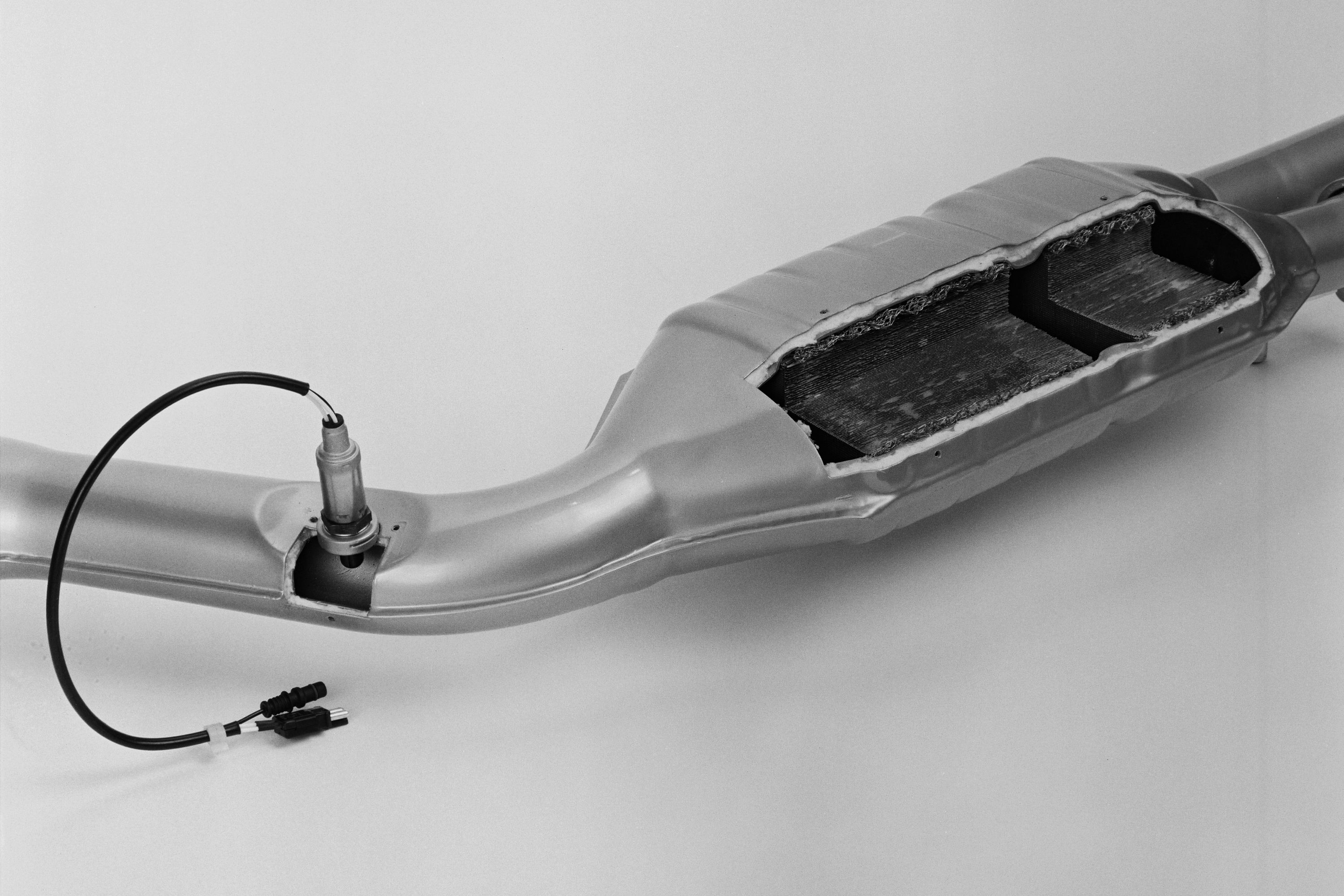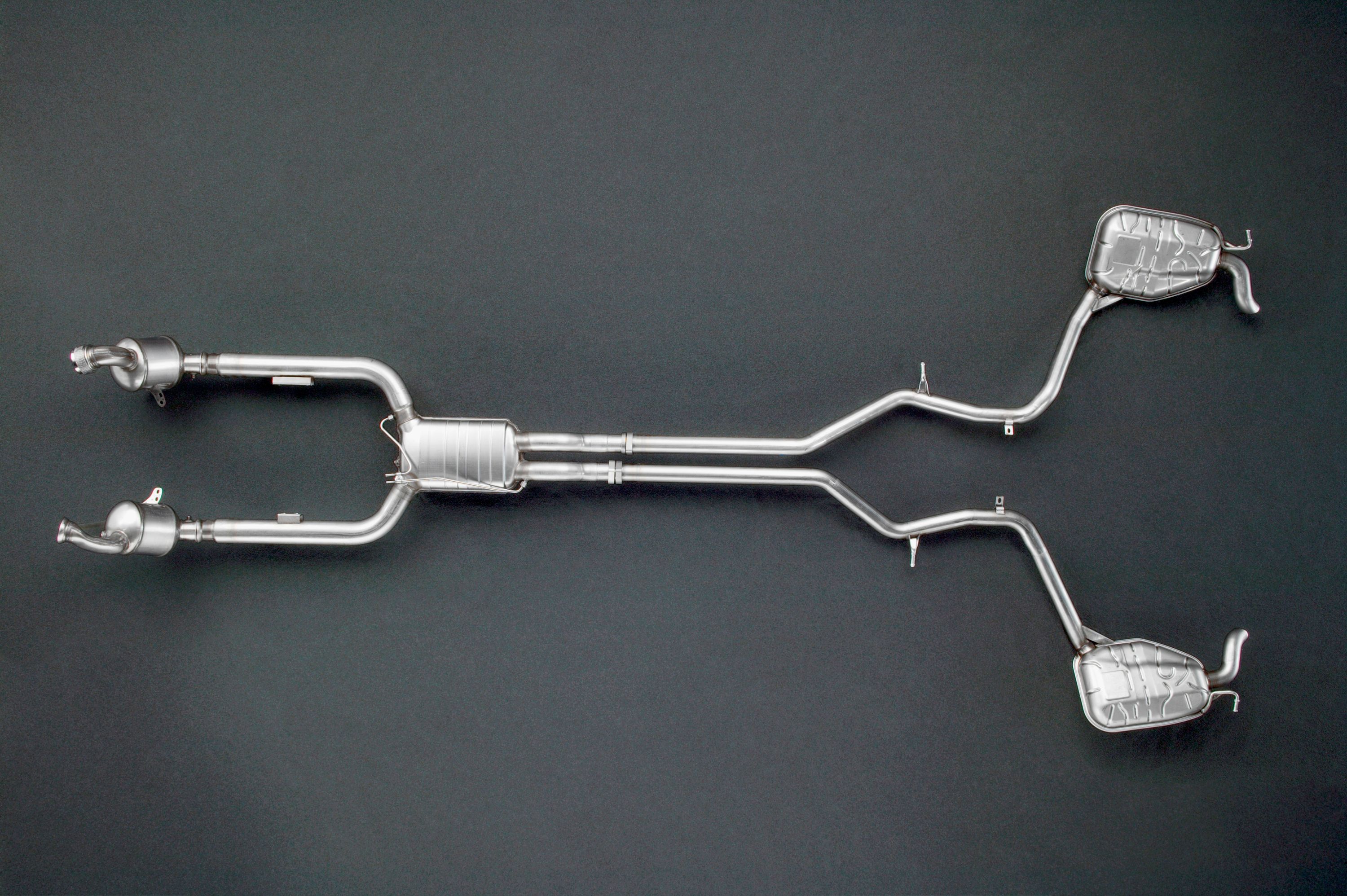
The fight against vehicle emissions is not a modern phenomenon, and the first big step was the compulsory fitment of a catalytic converter way back in the 1970s, though the device was actually invented twenty years prior. Designed to control exhaust emissions, a catalytic converter forms part of standard regulation exhaust systems on any vehicle with an internal combustion engine (ICE).
An ICE is basically just one big chemical process of releasing energy all the way from the combustion chamber to the exhaust. The historical meaning of its name comes from chemistry, where a catalyst is an accelerator for a reaction. In this case, the catalytic converter receives exhaust gases, a chemical reaction occurs, and some harmful particles are removed. A catalytic converter is responsible for transforming 98% of harmful emissions into less toxic emissions. Note, we say less poisonous and not harmless emissions.
What is an Exhaust Catalytic Converter?
Think of a catalytic converter as an air cleaner that uses chemistry to reduce and remove pollutants created by the internal combustion process. It's automotive mass manufacturing's answer to The United States Clean Air Act law, a set of emissions regulations enforced by the EPA. The act was first introduced in 1970 and required a drastic 75% decrease in harmful emissions within five years. As a result, every new car sold in the USA after 1975 will most likely have a catalytic converter installed. Here are some of the things you should probably know about these devices.
- They look more or less the same as a muffler, but underneath the stainless steel housing, you'll find a honeycomb mesh made up of precious metals including palladium, nickel, rhodium, cerium, and manganese.
- The most prominent metal used is platinum. Nearly half of all the platinum mined worldwide ends up in a catalytic converter.
- They're connected to the exhaust manifold via exhaust pipes on the one side and the gases exit on the other side via more piping.
- In terms of location, they're usually closer to the engine than the muffler. That's because of a high optimal operating temperature of 800 degrees Fahrenheit. To reach the right temperature, the ECU will idle the engine at higher rpm before settling down, resulting in angry sounds on a cold morning.
What Does a Catalytic Converter do?
Answering the 'what does a catalytic converter do?' question means knowing, firstly, that internal combustion engines aren't actually efficient. In fact, they only operate at around 20% to 30% efficiency. As a result, numerous byproducts are emitted from the combustion chamber through the exhaust manifold. This includes carbon monoxide, hydrocarbons, and nitrogen oxides.
This is then how a catalytic converter works: as these byproducts pass through the honeycomb mesh inside the catalytic converter (or cat, as it is known), two chemical reactions take place. The first is referred to as reduction, which is the process of breaking up NOx. The platinum and rhodium remove the nitrogen particle from NO and NO2, leaving O2. The second chemical reaction is oxidation, basically burning the hydrocarbons.
Types of Catalytic Converters
As with everything in the automotive industry, catalytic converters have evolved over time. Here is a breakdown of this evolution, as well as a look at a diesel catalytic converter, which works differently than units found in gas engines.
Two-way catalytic converters
The basic two-way converter was the automotive industry's answer to the US Clean Air Act. It's the most basic design, where exhaust gas flows in one side and out the other. The name comes from the two chemical reactions taking place on the inside. A two-way converter oxidizes hydrocarbons to create CO2 and water. It also oxidizes CO to form CO2. The two-way cat was replaced with the newer three-way unit because it wasn't as efficient at reacting with NOx.
Three-way catalytic converter
A three-way converter adds a third function, over and above the two-way converter. To do this, the catalytic converter is split in two. The first stage takes care of the NOx emissions, which is easier to do without oxygen. The second stage uses an air pump to add oxygen back into the mix, which is essential for the chemical reaction used to reduce hydrocarbons and carbon monoxide to CO2 and water.
Advanced three-way catalytic converters
Thanks to the introduction of engine management systems and sensors, the amount of O2 pumped into the catalytic converter can be controlled automatically. Sensors can tell when an engine is running lean or rich and adapt the amount of oxygen needed to make the converter as efficient as possible. Each sensor is connected to the vehicle's diagnostic setup, making it easier to detect a faulty converter.
Diesel catalytic converters
A diesel engine works differently than a gas engine. Instead of using a spark to ignite the fuel, a diesel engine uses compression and oxygen. Every diesel cat has a diesel oxidation catalyst, which performs the same function as the air pump on a gas engine. In addition to the gases released by an ICE, a diesel engine also releases other particles. This is the main reason why the war on diesel is currently raging so hard. To catch these particles, a diesel particulate filter (DPF) is fitted. This captures all of the bad stuff, containing it until it's burned up enough to pass through. The result of this burning process is CO2 and water. Read more about DPFs here.
How Long Should a Catalytic Converter Last?
You might be wondering how long a catalytic converter should last? Opinions on this differ. The estimate is anywhere between 50,000 and 100,000 miles. We feel that if a car is built correctly, there's no reason a cat shouldn't last the lifetime of the car. According to AARP, the average vehicle in the US travels between 12,000 and 15,000 miles per year. The Bureau of Transportation's research shows Americans keep a car for 11.8 years before it's junked. That's around 177,000 miles if we use 15,000 miles per year. So, theoretically, you may need to replace it once, but any more than that and there may be something wrong.
Symptoms of a Faulty Catalytic Converter
A catalytic converter should last a long time, but it can become blocked over time. Modern cars will warn you when something goes wrong (see our post on dashboard warnings for more information), so you should have enough warning to fix the problem.
Older cars equipped with a carburetor are more prone to gas and air mixture problems, causing the engine to run richer (hotter) than it should. A lot of fuel leaves the combustion chamber without igniting, ending up in the cat. Basic wear and tear (like seals) can also lead to all sorts of junk ending up in the catalytic converter. The clogging eventually leads to more heat than the metals on the inside can handle, so it melts.
Luckily, faults are easy to recognize - here are some faulty catalytic converter symptoms:
- As mentioned, a modern car will give you an engine warning light, and modern diagnostic tools will find the problem.
- Gas contains sulfur, which is one of the particles a cat is supposed to break down. If it's not working correctly, the sulfur will find its way through. So if you smell rotten eggs, get your cat checked.
- An engine requires a fully operational exhaust system. A faulty unit will block the system and lead to a loss of power.
- Some States, or areas located therein (primarily urban), require periodic emissions tests. Similarly, you may be required to test car emissions before a sale. A car with a broken catalytic converter will obviously fail these tests.
- A faulty catalytic converter will undoubtedly affect the entire engine. It will not be functioning optimally, which usually leads to an increase in fuel consumption.
- Lastly, if you hear a rattling noise under the car, it could indicate a problem with the cat, too. It's most noticeable when you start the car, but you will also hear the rattling underneath the floor when driving. It's harder to diagnose if a vehicle is well insulated.
After you've diagnosed the problem, you might be wondering whether it's best to try to repair it or replace it entirely. If you catch the problem early enough, a catalytic converter can be cleaned using an additive or by manually removing and cleaning it. Left unchecked for too long, the cat will melt, at which point a replacement will be required. The price of replacement isn't set in stone, but expect the cost to be anywhere between $1,000 and $3,000.
Why are Catalytic Converters Often Stolen?
The simple answer is that it's currently an easy way to make a quick buck. Because of the precious metals inside a catalytic converter, a thief can get up to $200 from a nefarious scrap dealer. You'd think a person trying to sell a cat without a car would be suspicious enough, but no. A scrap dealer can quickly get as much as $5,000 from the extracted metals.
The fact that a catalytic converter is so easy to steal also makes your Ford F-250 a prime target. Remember, a thief won't work systematically to avoid damage. They simply want to remove the part as quickly as possible, which usually means sawing and a sloppy removal. If your car, SUV or truck is higher off the ground, it's so much easier to get to, which is why many Toyota models such as the Tundra are currently being targeted. Toyota Prius converters are popular with thieves, too, as their hybridized powertrains mean the cat is in better condition.
To keep the cat safe, park in a garage or a secure area. Since this isn't always possible, there are two things you can ask the local shop to do. The first is to weld the catalytic converter to the car's frame. Part of the appeal of stealing these parts is that it can be done within a few short minutes. A welded cat is going to hold on for longer, possibly persuading the thief to move along. You can also stamp your vehicle's VIN on the cat, which will raise a red flag when the thief tries to sell it to a scrap dealer.
Catalytic Converter Laws
Laws differ from state to state, but the California Air Resources Board guidelines are applicable in most cases, as the rules are more elaborate than the EPA's. The EPA last updated the Clean Air Act on March 13, 1991. At the time, it sent out a fact sheet to exhaust repair shops with the latest guidelines. The laws are as follows:
- You may not remove the catalytic converter from your car and replace it with a pipe. In other words, it's illegal to decat the exhaust system.
- A new converter may be installed if a vehicle is missing one, when an inspection has proved that a new one is necessary, or when the vehicle's warranty has expired and there's a legitimate reason to replace it.
- When replacing a catalytic converter, it must be fitted in the same place as the original, and should also be of the same type as what is specified by the manufacturer - then, it also has to be installed with all the existing connections in place. The installer of said cat needs to provide an updated warranty information card.
- You may replace the catalytic converter on your car if it was made before 1996 and has more than 50,000 miles on it.
- There are no specific guidelines for selling a used catalytic converter, which is why theft is so prominent. In Alabama, for example, a scrap dealer must keep a five-year record of every purchase above $50. You can also sell a used cat online. In most cases, you will be required to do nothing more than sign a waiver stating that you did not get your hands on the part through illegal means.
Conclusion
A catalytic converter is the first step the automotive world took towards reducing emissions. It exists to break down harmful particles into less harmful particles through chemical reduction.
The converter is an essential part of the exhaust system, and you will notice when it's faulty. Replacing it is easy enough, but you have to be cautious when it comes to the rules.



